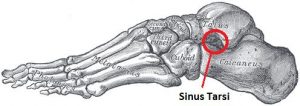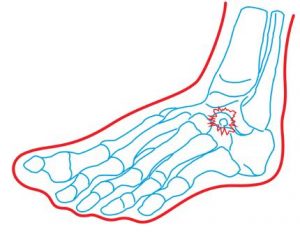It is said that Eskimos have a hundred nouns about “snow”, can you imagine it? Of course, there is no way, because in most people’s cognition there are only three words: “ice”, “snow”, and “frost”; but if you first tell you 100 Eskimo “nouns” about snow, maybe you can also Gradually feel the more delicate layers of their cold culture;
Similarly, I think: the name of the disease is the same. Especially the extended pain after an ankle sprain, there are many subtle differences, even can not be diagnosed through X-ray, just like the sinus tarsi, it is located in the deepest part of the foot, the principle is not easy to understand, but you must at least first Knowing this term will make it possible to find the correct diagnosis… otherwise you will have to be an unreasonable “foot ache wandering patient”!
When an ankle is sprained…
I believe that everyone has experience with ankle sprains. When an ankle sprains, if problems such as hematomas, ruptured ligaments, or even fractures occur, they must be dealt with urgently; the problem is often that the ankle does not produce acute symptoms at the moment of the sprain, so we do not So care, maybe push a push, maybe take a break, maybe… anyway, as long as the foot doesn’t hurt!
The terrible thing is: Although it doesn’t hurt right now, it seems to be OK, but afterward if you keep motionless, you will have pain in the anterior and outer ankles, which becomes a chronic problem. There are many possibilities for causing pain on the anterolateral side of the ankle, such as:
1. Damage to the anterior talofibular ligament: causing pain on the outside of the ankle, which is the most common phenomenon;
2. Fibula and Talus Compression Syndrome: There is a long thing between the fibula and the talus, squeezing it inside and causing pain;
3. Damage to the anterior talofibular area: due to the instability of the lateral ankle joint due to the injury, the pain point will also be in this area;
4. Sinus tarsi syndrome;
5. Tumor.

This seems to be a small area, but there are a variety of different sources of pain hidden. Although the location of the pain is also very close, if the diagnosis and treatment cannot be accurate, the difference is often a little bit, but it is a thousand miles away. Of course, The problem of ankle pain will never go away and will never get better.
Mysterious pain point: sinus tarsi
Many subtle differences in ankle pain cannot be fully diagnosed through X-rays. Among them, “Sinus Tarsi Syndrome” is more mysterious. Many doctors do not understand this part, and there is relatively little literature. Except for experienced doctors, they can use physiology. In addition to the diagnosis of the cause, the cause can only be diagnosed with a magnetic resonance scan (MRI).
In the days before MRI examinations, many doctors didn’t even think that “sinus tarsi syndrome” was a real disease. Therefore, for foot pain but the cause of which could not be judged, they were all counted on it, “sinus tarsi syndrome”. “It has become a trash can for sore feet. Nowadays, through the advancement of technology, imaging changes can be seen from MRI, and everyone has a better understanding of “Sinus Tarsi Syndrome”. It finally does not need to be blamed!
What are the pain points of “Sinus Tarsi Syndrome”?
Generally speaking, the pain point of “Sinus Tarsi Syndrome” is a little lower than the pain caused by the general anterior talofibular ligament, and it is also a little lower than the painful position of the crush syndrome, but it is more than the damage of the metacarpal joint ligament. A little bit above the pain. Because the pains of these symptoms are all nearby, and the gap between them is very slight, many people have sprained feet, and they can’t tell it clearly, and it’s hard for ordinary doctors to diagnose the correct cause.
The sinus tarsi is located in the middle of the four bones of the calcaneus, talus, and cubic calcaneus scaphoid. It is connected by ligaments at the deepest part of the ankle and is full of fat and nerves. Compression, deformation, or damage to the ligaments (with nerves) inside, causing ligament pain. This is the “sinus tarsi syndrome”, which is of course not visible on the X-ray because it is hidden in it for a dull pain.

In addition to a specific location, “Sus Tarsi Syndrome” has another characteristic: it will be more painful if you rotate the soles of your feet in and out.
The biggest trouble for patients with “sinus tarsi syndrome” is not the treatment, but the failure to diagnose it. If it fails to be diagnosed, there is relatively no treatment, and the pain problem cannot be relieved. In other words, how to make the correct diagnosis and find the correct treatment in the fastest time is very important for the patient.
The pain points of tarsi tunnel syndrome and heel pain are also very different!
Further discussion, “Sinus tarsi syndrome”, “Tartus tunnel syndrome” and “Heel pain” have very different parts of the ankle pain:
*The main pain point of “Sinus Tarsi Syndrome” is the outer front side of the footplate and the ankle junction: when the footplate is twisted, that place will feel more painful, which is different from the pain of joint instability caused by the damage of the anterior talar ligament. It is pain in a deeper, sunken area.
*The main pain point of “tarsal tunnel syndrome” is on the inner ankle: when the nerves in the inner tarsal tunnel of the ankle are compressed, causing numbness in the soles of the feet, it is called tarsal tunnel syndrome. The main pain point is under the inside of the ankle, and there will be an electric sensation when it is numb.
*The main pain point of “heel pain” is on the inside of the sole: the pain point of root pain is located behind the pain point of “tarsal tunnel syndrome”, and most of them feel tenderness when stepping on the ground, the feeling of tenderness and pain and “tarsal tunnel syndrome” The tingling sensation is different.

You need to know the “noun” before you know why, and then you can prescribe the right medicine!
Some people say: To understand the Eskimos, start from the hundreds of nouns (powder snow, wet snow, goose feather snow…) that the Eskimos use for snow. Similarly, I think: the name of the disease is the same.
Especially for foot and ankle diseases, there are many Chinese terms for diseases that were shared with netizens. For clarity, they are defined one by one. Chinese literature is almost unavailable. It is no wonder that many terms may even be associated with orthopedic doctors. Never heard of it, let alone ordinary people.
Therefore, I think we should first define the nouns, and start from the “nouns” to understand why, so that this blog can help everyone have a comprehensive and general understanding of the ankle and ankle diseases and problems, and then they can think about and distinguish between individuals, relatives, and friends. What may be the disease?” In this way, it will be easier to find a way to a successful treatment, rather than using painkillers to deal with all the pains.
Hot blogs:
The Easiest Custom Insoles: Heat Moldable Insoles
Custom insoles, also known as orthotic insoles, are designed to provide personalized support and comfort for individuals with various foot conditions. In [...]
Children’s Insole Size Conversion Chart
The standard sizes for shoe insoles may vary from country to country, making it a headache to choose the right insole for [...]
Do custom orthotics need to be made by a doctor personally?
Custom orthotics do not necessarily need to be made by a doctor personally. While doctors, specifically podiatrists or orthopedic specialists, are often [...]
Do NBA players use custom insoles?
Custom insoles are not only helpful for people with foot health issues, but they also play a significant role in targeting the [...]
